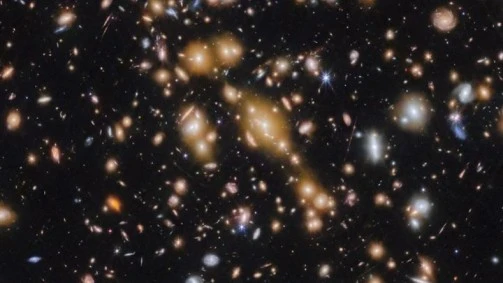Recently, astronomers with the help of the James Webb Space Telescope (JWST) discovered clusters of stars in the arc of “cosmic pearls” that flourished 460 million years after the Big Bang. This is considered the remarkable first discovery of star clusters in a tiny galaxy, as it was when the 13.8-billion-year-old universe was less than 500 million years old.
Newly discovered stars
Astronomers have discovered five infant star clusters, possibly the oldest ever, dating back to the universe’s infancy. These gravitationally bound massive clusters can provide important clues about the reionization age of the universe, estimates an international team led by Stockholm University with collaborators from selected European countries, the United States, and Japan.
Also Read | US Praises India’s Lok Sabha Elections, “Largest Exercise Of Democracy In The History Of World”
Originally discovered by the Hubble Space Telescope and officially named SPT0615-JD1, the Cosmic Pearl Arc is a gravitationally lensed galaxy located about 13.3 billion light-years from Earth. This means that the light seen by JWST from this galaxy has traveled to Earth for about 97% of the lifetime of the universe.
These galaxies are thought to be the main source of intense reionizing radiation in the early universe,” said lead author Angela Adamo of Stockholm University
A New Opportunity for Astronomers
Webb Telescope offers an unusual opportunity to study star formation and the formation of tiny galaxies at such an unprecedented distance “Webb’s incredible sensitivity and angular resolution at near-infrared wavelengths, combined with the massive gravitational pull of the foreground galaxy, made this possible” explained Larry Bradley of the Space Telescope Science Institute and the Webb Observing Program PI.
“No other telescope could have made this discovery. The surprise and amazement were incredible when we opened the Webb images” Adam added.
Also Read | China’s Chang’e – 6 Lunar Passage Returns To Earth With Samples From Far Side Of The Moon
Milky Way Galaxy
Our Milky Way Galaxy contains many ancient gravitationally bound globular star clusters that have survived for billions of years. These clusters are remains of intense star formation in the early universe, however, their exact origins and times of formation are not known. The detection of huge young star clusters in this arc could set off some studies of the early stages of the star formation process and its subsequent evolution to globular clusters. This discovery is crucial because it allows scientists to better understand how and where infant galaxies are formed.
About the Author
Simran Akhouri is a postgraduate student in journalism from the University of Delhi. She has developed strong writing skills that allow her to convey stories. She is passionate about uncovering the truth and delivering it to the public in an engaging and accessible manner.











